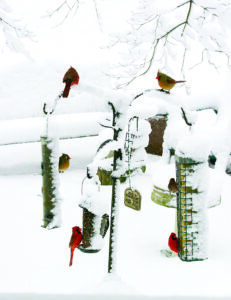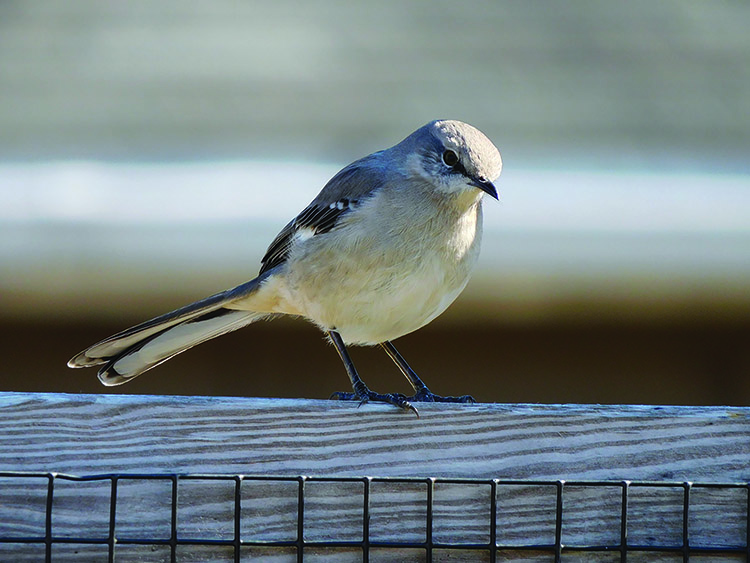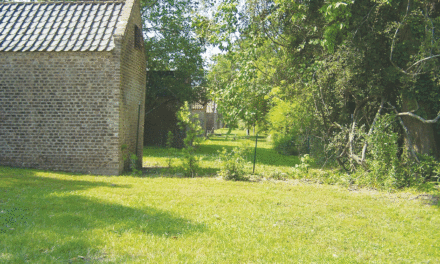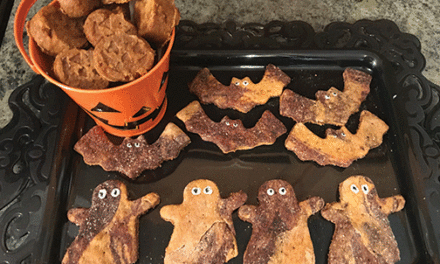
Splashes of color come in the form of the ubiquitous bright red Northern Cardinal when trees are leafless or even covered in snow. (Photo courtesy Ron Ketter)
As colder, shorter days and frostier nights arrive, some ruefully suggest that winter is “for the birds.”
Turns out, when chilly winds blow, many Mid-Shore feathered backyard denizens do stick around. How do they fare foodwise during the colder months? And what’s the best way to help?
Judy Wink, Executive Director of the Chesapeake Bay Environmental Center in Grasonville, has been a dedicated birder since childhood.
The eagle-eyed Wink has spotted many common species over the winter months, including Carolina Chickadee, Tufted Titmouse, Northern Mockingbird, Mourning Dove, White-breasted Nuthatch, Dark-eyed Junco, Blue jay, Downy Woodpecker, Hairy Woodpecker, American Goldfinch, House Finch and Northern Cardinal.
Harrison Jackson, teacher/naturalist and outreach coordinator for Pickering Creek Audubon Center in Talbot County, advised backyard birders that distinctive sights and sounds abound.
“There are many species of sparrows, like the White-Throated Sparrow with its distinctive triplet call that sounds like old-Sam-peabody-peabody,” Jackson advised. There’s the small grey Tufted Titmouse with spiky “mohawk” hair and the darker grey and black Dark Eyed Juncos.
Splashes of color come in the form of the ubiquitous bright red Northern Cardinal or the larger (and much louder) blue and white Blue Jay. Bigger birds like Woodpeckers show up, too — Hairy and Downy Woodpeckers (smaller) or Red-Bellied or Red-headed Woodpeckers (larger). But look down every once in a while, because Mourning Doves love to eat seeds that have fallen from hanging feeders.”
Ron Ketter has been feeding birds for at least 30 years. A member of Talbot County Bird Club, the local branch of the Maryland Ornithological Society, he also volunteers at the Blackwater National Wildlife Refuge and Pickering Creek.
Ketter noted that while different birds have specified tastes and needs, there is some overlap.
“Black oil sunflower seeds attract the largest number, including Carolina Chickadees, Tufted Titmice, Sparrows, Nuthatches, Finches, Cardinals, and Blue Jays. Nyjer thistle attracts Finches and Pine Siskins.
Woodpeckers prefer suet, as do Nuthatches, Chickadees, and Titmice. If you have wintering Bluebirds, try putting out some dried mealworms,” he said.
“Feeder type also matters. Among the most common types is a tube feeder, round with holes at various places for birds to access food with places to perch while feeding.
They’re especially good for smaller songbirds, but harder for other birds, such as the Northern Cardinal.
Putting up a platform or hopper feeder with black oil sunflower seed will bring these birds in,” Ketter recommended.
“Nyjer thistle requires a feeder with small opening due to the small seed size. An inexpensive way is using a “thistle sock” — a long skinny open-weave cloth bag. Suet comes in cakes, which fits easily into a suet cage, ranging from very simple to more complex,” he continued.
“To attract ground birds like Mourning Doves, toss some cracked corn on the ground, staying mindful this can attract squirrels and raccoons,” Ketter suggested.
For post or hanger feeders, a squirrel baffle may work, or a cage feeder that keeps squirrels and larger songbirds such as grackles out, while giving smaller birds access, he said.
Jackson addressed the issue of feeding different sized birds. “Adding large in shell peanuts to a larger, more open peanut bird feeder, attracts larger nut eaters like blue jays and nuthatches, but some smaller, including tufted titmice and chickadees, can also use it,” he mentioned.
Suet, which is high in fat and calorie dense, is a crucial food source for overwintering birds; offering a cake in a feeder with a tail prop helps bring in woodpeckers, Eastern bluebirds, mockingbirds and nuthatches, Jackson added.
Wink noted that most backyard birds tend to be seed eaters, and commonly consume sunflower seeds, but there are two types — striped and oil.
The oil variety is most nutritious but a bit more expensive than striped.
High protein Nyjer seeds are also widely favored by many.
Cracked corn, the smallest grind, is best for all birds, with grind being critical, she noted.
And the best overall backyard bird feeder mix combines finely cracked corn, oil and striped sunflower seeds and cracked peanuts.
It’s less expensive and more nutritious than costly packaged mixtures, which often contain millet and other seeds essentially as empty calorie filler. It also leaves less waste on the ground, a hazard bringing ground feeding birds into contact other droppings, mold, fungi, etc.,” Wink said.
Maintaining and cleaning bird feeders is as crucial as feeding, all three avian observers agreed.
Warning that a lack of rigorous care can contribute to spreading disease, Jackson stressed experts’ recommendations to regularly take down feeders and clean thoroughly with a solution nine parts water to one part bleach.
“Make sure to scrub it down first, wiping off gunk or debris,” Jackson said.
Then let dry completely before putting back up and filling. Clean underneath feeders and remove any rotten fruit or food to dissuade rodents.
For storing and handling food, keep dry seeds, nuts, etc. in a large metal trash can or storage container with a locking lid.
Keep suet cakes in fridge or freezer to keep from spoiling,” Jackson added.
“Birds prefer feeding on their natural foods as long as the resources last into the winter. When the natural foods “dry up” they will go to backyard feeding stations to supplement their diet. Supplement is a key word. The birds search their haunts for their natural foods, but if not available, go to a feeding station provided. When insects and grubs become slim pickings in a woodlot for the woodpeckers in search of the bugs and grubs, a suet ball or slab will supplement the need for fat/protein,” Wink said.
She also warned of the danger of backyard feeding bringing birds into close contact that would not be the case in their natural habitat.
That draws avian predators, particularly sharp-shinned hawks and Cooper’s hawks, who feed primarily on small birds; the feeder becomes their “convenience store.”
“Cover for the birds is critical for protection from lurking predators — bushes, grasses, hedges, and similar cover when crossing open areas en route to feeders, a place where they can dart away from danger,” Wink cautioned.
Ketter urged people to remember the dangers presented by outdoor cats.
He also pointed out another all too common problem.
“Birds flying from feeders into glass windows is a real risk, contributing to unnecessary bird mortality.
Feeders placed within 3 feet of a window are safest, since the birds will likely notice the window and if they don’t will probably not have built up enough speed for serious injury,” he stated, while 20 feet away provides an even greater deterrent, and recommended the following link for Cornell’s Ornithology Lab, https://www.allaboutbirds.org.
Two years ago, Ketter crafted his own “zen curtains” simply and inexpensively from a roll of parachute cord (https://www.birdsavers.com/make-your-own) and hasn’t had a single strike since.
In addition to providing safe, supplemental food, don’t forget about water, the experts each advised.
“It is ideal if you have a ‘running water feature’ or ‘heated bird bath’ in the backyard,” Wink said. “The birds will seek this over food. They need to drink and bathe everyday even in the winter. A water feature can be as simple as an electric ornament that drips water from one level to another or an elaborate in ground ‘waterfall feature.’ A heated bird bath is fine. Both need some maintenance to keep clean (leaf debris removed, bird droppings scrubbed away, water changed in bath, check on electrical connects, etc.)”
“Installing a fountain, a bubbler, or even a drip system is also just a great way to attract birds to your garden,” Ketter said.
For more information: https://feederwatch.org/wp-content/uploads/2013/10/BirdNote01-Winter-Bird-Feeding-_for-PDF_2012-10-22-RGB.pdf.






